Symbolic Meaning of the Raven in Native American Indian Lore
The symbolic meaning of the Raven in Native American Indian lore describes the raven as a creature of metamorphosis, and symbolizes change/transformation.
In some tribes, the Raven is considered a trickster because of its transforming/changing attributes.
Often honored among medicine & holy men of tribes for its shape-shifting qualities, the Raven was called upon in ritual so that visions could be clarified. Native holy men understood that what the physical eye sees, is not necessarily the truth, and he would call upon the Raven for clarity in these matters.
Foremost, the Raven is the Native American bearer of magic, and a harbinger of messages from the cosmos. Messages that are beyond space and time are nestled in the midnight wings of the Raven and come to only those within the tribe who are worthy of the knowledge.
The Raven is also called upon in Native ritual for healing purposes. Specifically, the Raven is thought to provide long-distance healing.
The Raven is also a keeper of secrets, and can assist us in determining answers to our own “hidden” thoughts. Areas in our lives that we are unwilling to face, or secrets we keep that harm us – the Raven can help us expose the truth behind these (often distorted) secrets and wing us back to health and harmony.
Puja is a ceremony officiated by a Lama and two or more monks in front of an altar built of stone. Those performing a puja ask the Gods for good fortune for the sherpas and the climbers as they attempt to summit the mountain. In front of the altar, offerings are made to the Gods: sampa cake, yak milk butter, fried dough, fruits, chocolate, and drinks. Juniper burns continuously in a niche in the altar.
All the critical climbing equipment is blessed — harnesses, crampons, ice-axes, and helmets, as well as the expedition flag. Prayer flags are strewn for 100 feet in several directions. During the ceremony, the sherpas chant along with the Lama and monks, and everyone throws rice. The sherpas raise a pole with juniper branches on the top, and it is a sign of good fortune if a gorak (raven) lands on the pole. The ceremony closes with the participants sharing food, and finally with the climbers and sherpas smearing gray sampa flour on each others’ faces — a symbol of their hope that they may live to see each other when they are old and gray.
